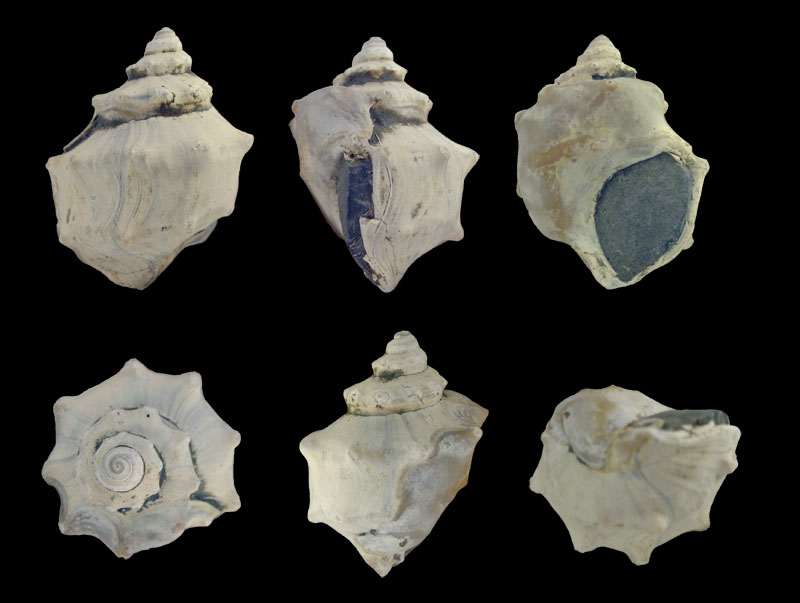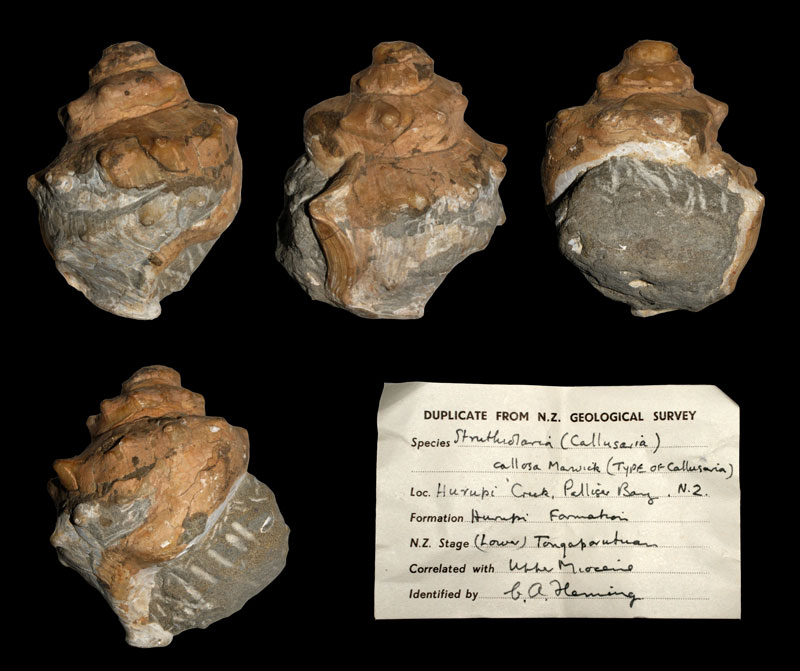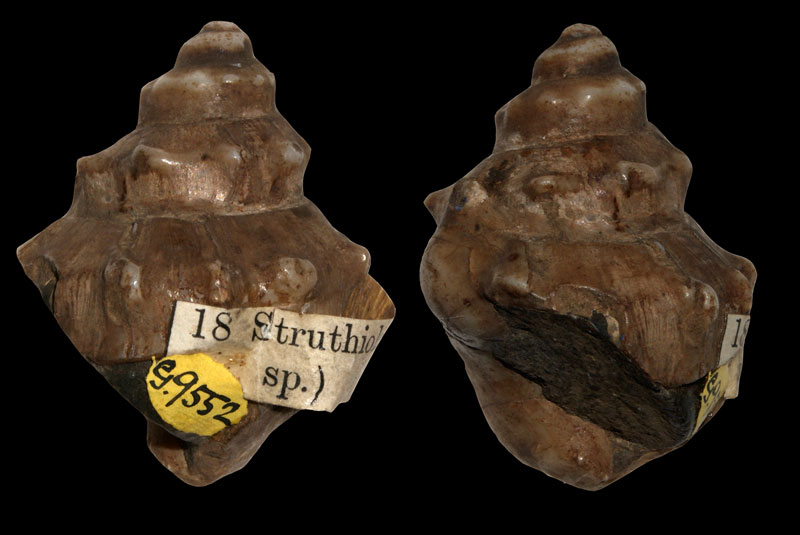|
edit SideBar
|
Species / Callusaria Callosa
Stromboidea
Original Description of Struthiolaria callosa by Marwick, 1924:
- ” Shell large, ovate, with gradate spire, about same height as aperture; whorls five, angled about middle with wide slightly-included shoulder, body-whorl bicarinate; sculpture, fine regular spiral threads on upper whorls, becoming obsolete on lower, the shoulder-angle furnished with about 8 distant strong tubercles, lower keel also has tubercles but smaller and more numerous; suture slightly undulating, filled with layer of enamel which towards aperture reaches to tubercles above; aperture inclined, ovate; outer lip reflexed, moderately thickened, wedge-shaped, sinuous, projecting slightly at shoulder but more so at lower keel, bent then in wide shallow sinus to anterior canal; columella concave, bent to right below and ending in rounded beak; inner lip with enormous callus-pad reaching suture above, ending below about middle of base with rounded knob which is separated from beak by deep rounded lightly-calloused channel; similarly at its junction with outer lip above, pad ends in rounded knob, causing a channel on shoulder."
Locus typicus: 300 yards above mouth, at base of Tertiary beds, Hurupi Creek, Palliser Bay, Wairarapa, North Island, New Zealand
Stratum typicum: Tongaporutuan, late Miocene
Dimensions Holotype: Height, 70 mm.; diameter, 50 mm.
History and Synonymy
Callusaria callosa (Marwick, 1924)
- Struthiolaria armata Marwick 1924:183
- Struthiolaria fortis Marwick, 1924:183
1924
Original Description of Struthiolaria fortis by Marwick, 1924, p. 183:
- "Shell small, ovate, with gradate spire shorter than aperture; whorls 5 remaining, angled about middle with sloping shoulder, body-whorl bicarinate; sculpture, shoulder with few obsolete spiral threads, angle armed with 7 or 8 strong tubercles, and keel with smaller and closer ones, growthlines very strong, suture undulating and showing layer of enamel getting higher towards aperture; aperture inclined, semilunar, produced into very short canal below; outer lip reflexed, thickened, wedge-shaped in cross-section, bisinuous, more projecting at lower keel than at shoulder-angle; inner lip with enormous pad, not surmounting shoulder, but very thick and with strong projecting ends, forming channel between beak and basal end of pad, and another on shoulder; columella concave, strongly bent to right below."
- Localities: "1035 (holotype), Shelton's Whare traverse, Block XI, Tutamoe Survey District, Raukumara Division (E. O. Macpherson); 1044, Motumati Waterfall, Waingaromia Survey District, Raukumara Division (= S. calcar Hutton of Marshall, 1910, N.Z. Geol. Surv. Bull. No. 9 (n.s.), p. 22)."
Original Description of Struthiolaria armata by Marwick, 1924, p. 183:
- "This species resembles S. spinifera just as S. callosa resembles S. spinosa. It has a high spire with very sloping shoulders and long strong spines on the shoulder-angle, 7 to 8 on the body-whorl and 6 on each of the spire-whorls. The suture is filled with a layer of callus which ascends to the tubercles above, while the inner-lip pad extends to about half-way between the tubercles and the suture, but does not quite bury the spines. The growth-lines are very strong, but there is no spiral ornamentation. As only spires of three specimens are available, full specific description cannot be given, but the characteristic and easily identified spire justifies the application of a specific name."
- Localities: "Muddy Creek, Tutamoe Survey District, Raukumara (M. Ongley and E. O. Macpherson); 1034, lowest band, Shelton's Whare traverse, Block XI, Tutamoe Survey District."
2009
Beu & Raine, 2009:
- "Marwick (in an unpublished oil company report, 1960) reconsidered this evolutionary series and tried to evaluate changes in the height of the spire, number and prominence of the peripheral nodules, prominence of the apertural callus, and extent to which the parietal callus rides up over the nodules onto the sutural ramp, leaving a callus smear on the previous whorl. Allowing for some re-dating of localitities, this provides some possibility of recognising S. fortis (= S. armata) as an intermediate form in a lineage leading from S. spinosa to S. callosa, although he admitted that it was based on few populations and needed amplifying. According to Marwick's report, S. spinosa is characterised by the apertural callus reaching below or about to the shoulder angle, with 8-9 prominent peripheral nodules per whorl, the spire equal in height to the last whorl, and no callus band on the previous whorl. S. fortis is characterised by the apertural callus reaching the shoulder angle, with 7-8 very prominent peripheral nodules per whorl, the spire 3/4 to 5/8 of the height of the last whorl, and a wide callus band on the last 2-3 whorls. Finally, S. callosa is characterised by the apertural callus reaching right across the shoulder to the suture, with 8-11 smaller peripheral nodules, the spire 2/3 to 3/5 of the height of the last whorl, and a wide callus band on the last 3 whorls. However, this appears to be an excellent example of an anagenetic series, and it is doubtful whether the subdivisions can be recognised outside the type areas of the named species. The traditional usage of S. spinosa and S. callosa as distinct species is recommended here, and the series of vaguely defined intermediate forms that possibly can be used in biostratigraphy is not recognised as separate species."
 Callusaria callosa (Marwick, 1924); Tongaporutuan, Miocene; Palliser Bay, Wairarapa, New Zealand; 52 mm; Coll. Virgilio Liverani
Struthiolaria (Callusaria) callosa (Marwick, 1924); lower Tongaporutuan, Miocene; Hurupi Creek, Palliser Bay, Wairarapa, North Island, New Zealand; 58 mm; Coll. BM(NH); Copyright BM(NH)
Struthiolaria sp.; Miocene; Eastern Wairarapa, North Island, New Zealand; Coll. BM(NH) no. G.9552; Copyright BM(NH)
References:
- Beu & Raine 2009. Revised descriptions of New Zealand Cenozoic Mollusca from Beu and Maxwell (1990). GNS Science miscellaneous series no. 27, Fulltext
- Marwick, 1924
|



